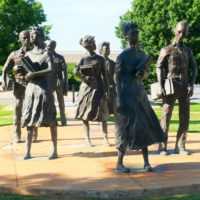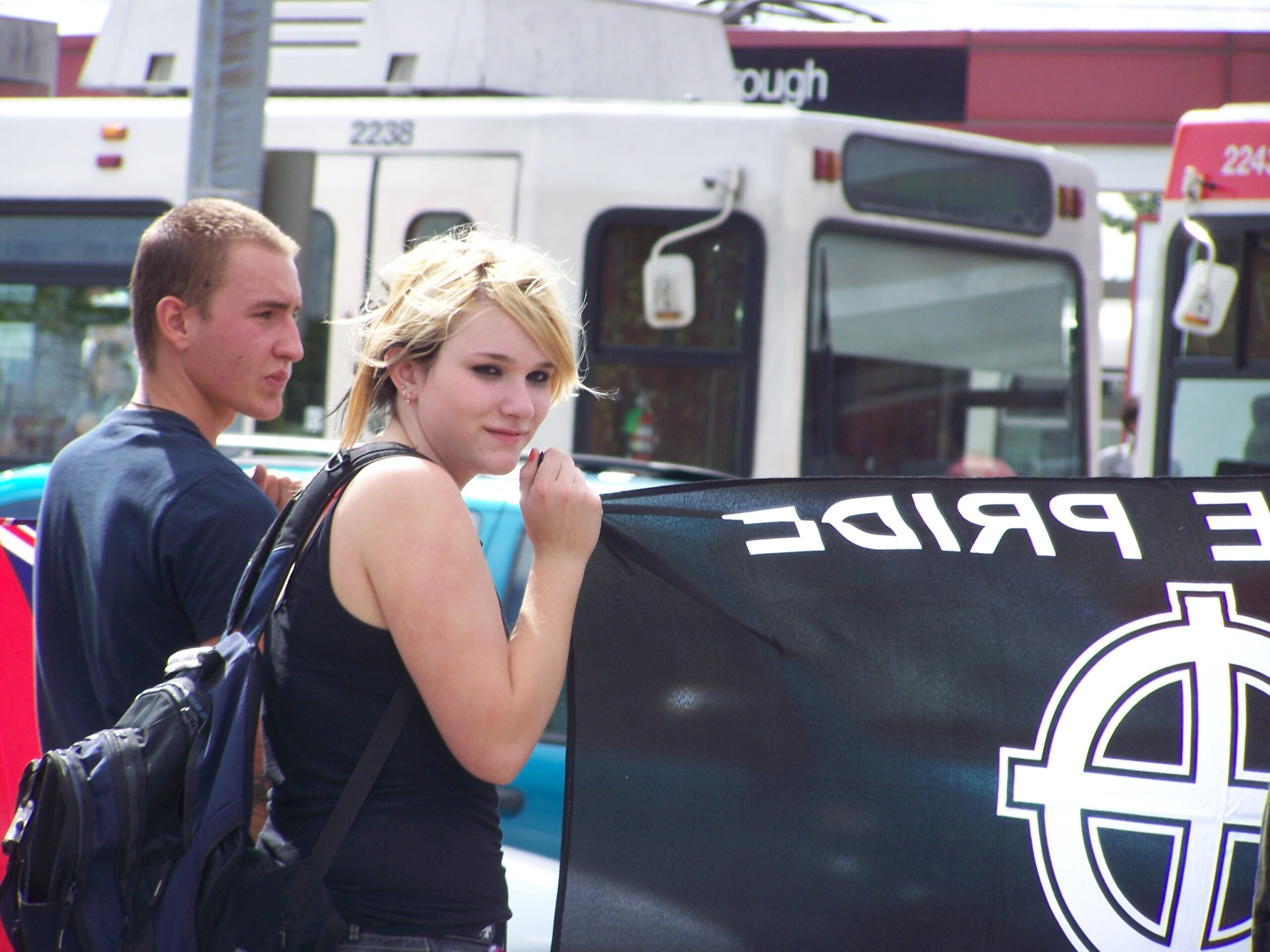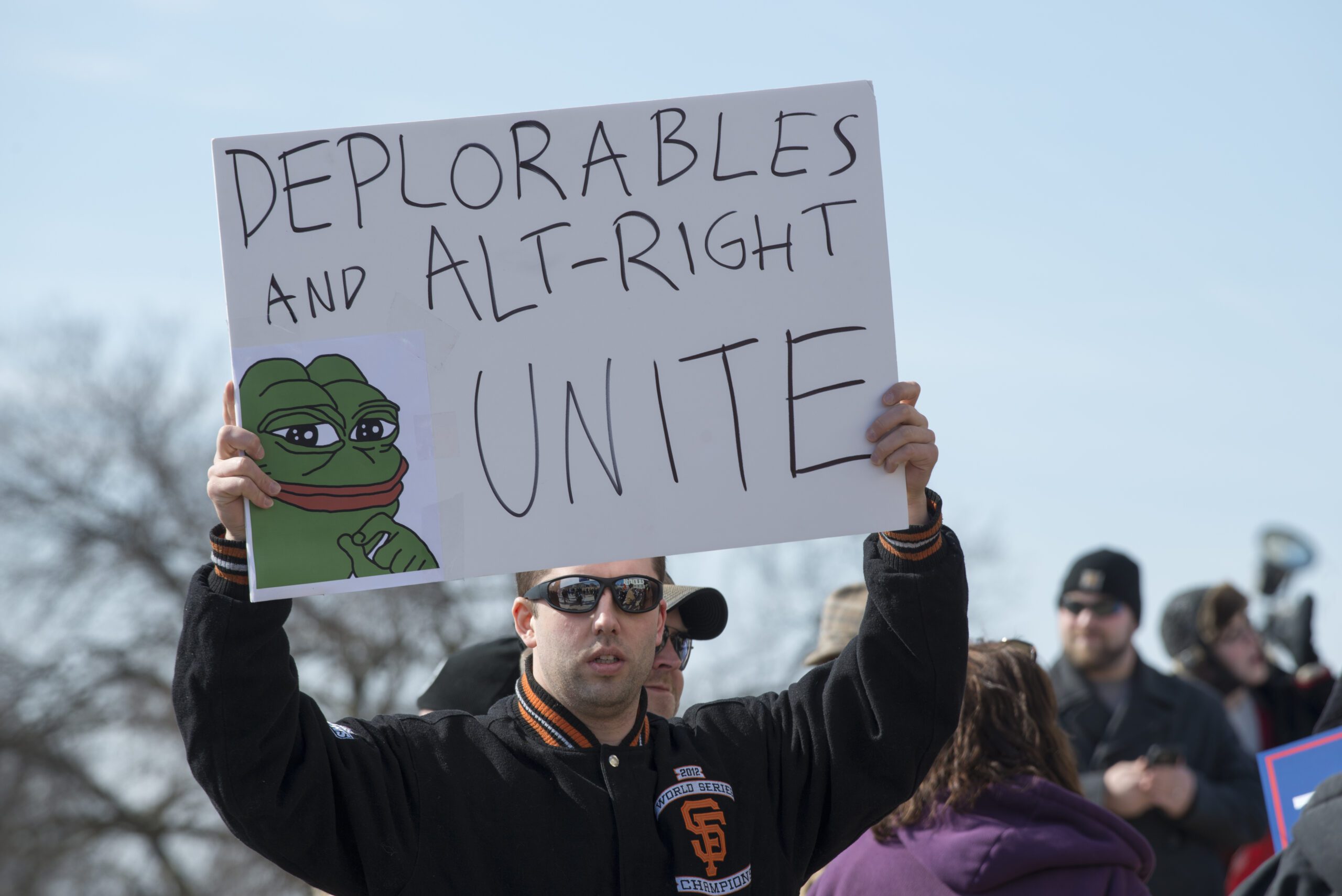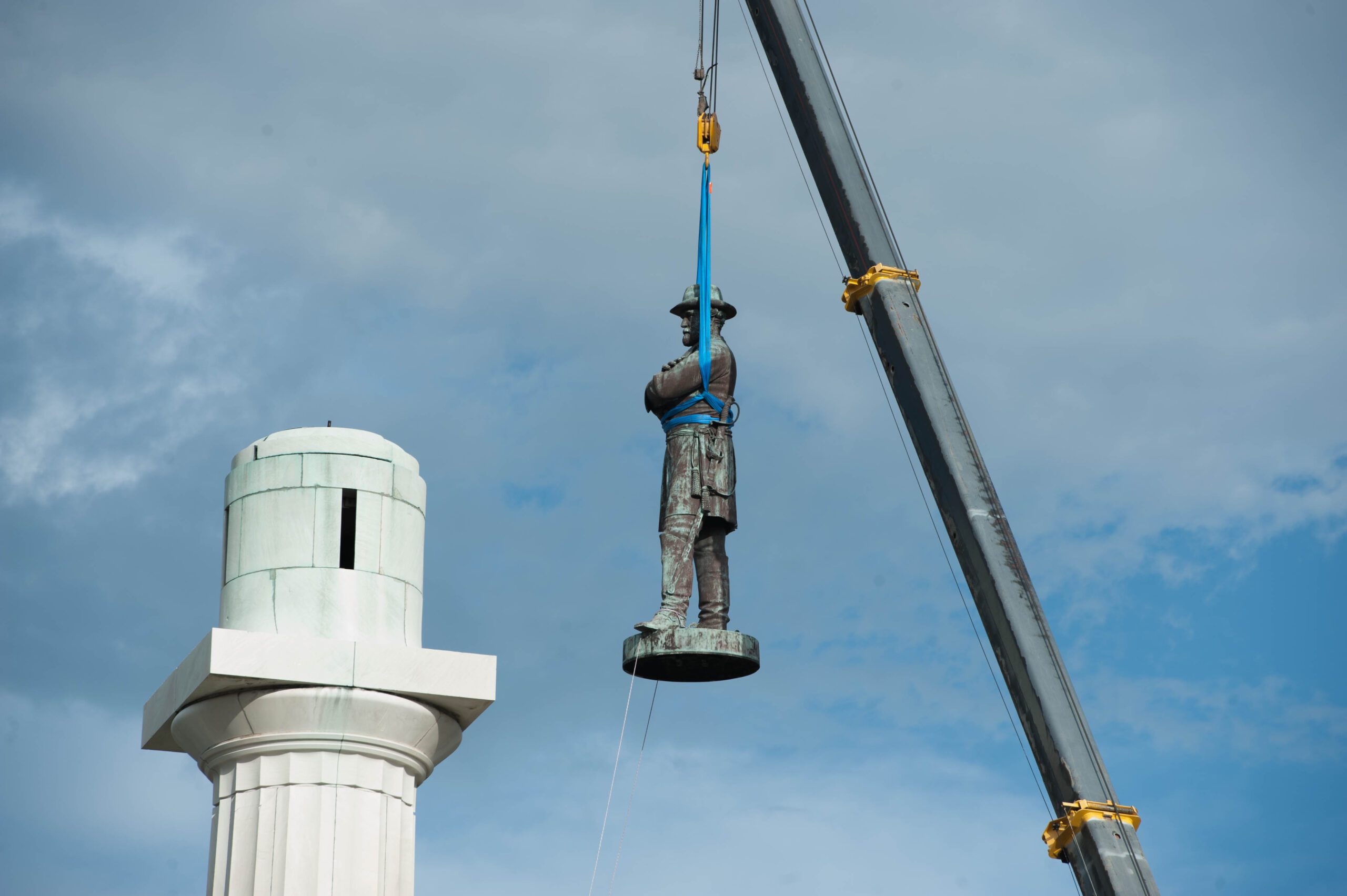Their names are Hazel Bryan and Peter Cvjetanovic. We don’t know them personally, but we know who they are. We know Hazel for yelling at classmate Elizabeth Eckford while she was retreating after her attempt to integrate a high school in Little Rock, Arkansas sixty years ago today. In what biographical historian David Margolick calls “the most famous photo of the Civil-Rights era,” photographer Will Counts of the Arkansas Democrat caught Hazel mid-epithet, preserving forever the moment of her vicious assault. We remember Hazel’s forward-moving body, her violently clenched brow, her rounded mouth, and bared teeth. We don’t know the exact words she was shouting, but we know that whatever they were, they were violent.
Sixty years later, the US is still caught in the conundrum that Counts’s photo preserved: our slavery-based race and class hierarchies and the us/them-ism that plays out in ugly ways in public spaces. Hazel’s face invokes all of this, and she came to many minds last month when we saw Peter’s angry countenance at the white supremacy rally in Charlottesville, Virginia. Even a quick reflection on the images emerging from today’s race-class war reveal that these images—both well known and lesser known ones—function as both lenses and mirrors. They show us what we want to know about the people in the pictures and what we ought to want to know about ourselves.
In Cvjetanovic’s image, which swiftly went viral, photographer Samuel Corum froze him in time in what appears to be utter hatred: the young man stands at the foot of a Robert E. Lee statue, looking venomous, screaming, and, according to Corum, “chanting white nationalist slogans.” His face, like Hazel Bryan’s, would be a handsome if it weren’t all balled up in anger. What are they so mad at? one can’t help but wonder. What is he yelling?
It could’ve been, “You will not replace us!” or “White Lives Matter!” or “Enough is enough! Arise!” It could’ve been, “Proud of my heritage!” or “Leave our statues alone!” It could’ve been something about the importance of Robert E. Lee’s supposed contribution to “white European culture”—something that Peter believes is in danger of being erased. It seems like such a strange thing for him—or anybody—to be worried about.
Still photos are important in that way, though. They grab what otherwise might feel too foreign to understand. They capture the essence of a thing, which, in both Counts’s iconic photo and Corum’s milieu-defining one, appears to be very young people expressing rage at something or someone unlikely to harm them. But such hyper-dramatic photos also feed into the American preference for oversimplifying things. They enable us to believe in Hazel’s and Peter’s lowest selves more than we wonder about the totality of their beings.
If we focus on the despicableness of alt-right youth or their supposed unintelligence—for many educated people see images of mobilized alt-right youth and say, “stupid,” “redneck,” “dummy,” and “idiot”—we avoid feeling something that we don’t want to feel. We lash out at these young enemies and blow off steam about the Trump administration, but we don’t let ourselves wonder if it is really we who feel sort of stupid. We might, for example, feel stupid for failing to see white supremacy gathering momentum to strike, for letting it get this big. We might feel dumb for failing to protect our voting booths from hackers, for failing to get our candidate elected this time, or for failing to understand so many of the ways our countrywomen and men really think. We might feel foolish for believing we were further along in finishing the work that Reconstruction begun so long ago. Some portion of this name-calling, then, could be Freudian projection, and the drama is a distraction from moving forward.
But the same media lens that captures white supremacy in its most unfathomable moments also gives us exactly what white supremacy wants us to see: its formidable commitment to oppressive ideas and its overwhelming power to harm. Beyond precluding a more nuanced curiosity or keen reflection, this shocking imagery gives some people the opportunity to be appalled and call it a day.
Those who are inclined neither to nuanced understanding nor disgust, may, instead, be shocked. These viewers might see hate crime depictions—like photographer Ryan M. Kelly’s image of James Alex Field Jr.’s car plowing into a group of protestors—and think, like the Washington Post’s Alyssa Rosenberg did, that that “the world, quite literally, seems to be turned upside down.” These jarring images can trigger viewers to be surprised about what sucks about our country, even though we should know that white supremacy sucked all along. Rosenberg laments that “[t]he rules do not apply, and anything is terrifyingly possible” now that Fields has been photographed killing one and wounding so many others. It’s a strange naiveté to believe that “the rules” ever did “apply” when dealing with race and racism in the US.
This fatalistic focus on the alarming and the scary concerns me because it could prevent the Alarmed and the Scared from asking practical questions, like, “Is there anything I can do to free my own people from our supremacist myths?” And, “How has my community failed to meet the needs of entire populations of our youth that have found each other and been led into hate groups?”
When I look into the faces of the above white supremacist teens on their way to or from a white power march, when they are not yelling or fighting, I have space to wonder if someone can get to them before it’s too late.
As I myself learned in my decade or so of working among at-risk, often gang-affiliated Black and Hispanic urban youth, there are conditions that predispose young people to being absorbed into crime and hate groups: poverty, family violence, broken homes, poor education. Former neo-Nazi and founder of Life After Hate, Christian Picciolini, concurs, and says that that young white supremacists “become radicalized, or extremist, because they’re searching for three very fundamental human needs: identity, community, and a sense of purpose.” Many may feel, according to sociologist Arlie Russell Hochschild, that their “standard of living, their worldview and basic identity, [are] already set on a floor of Jell-O.” They are unclear about how to fare well “in the era of an expanding bottom, spiking top, and receding middle class.” And so Picciolini looks for ways to help white supremacist youth build a solid floor of survival and to work through past trauma before he begins to set about helping them dismantle their racist ideologies. His work reminds me of the gang-truce negotiators in my town of DC.
When we look beyond the shocking images and profoundly ugly deeds, when we look underneath our own more comfortable feelings and allow ourselves to be persuaded by people like Picciolini, our narrative is made more complex. It comes to suggest, if not solutions, at least points of intervention. But too often those same people that indulge in name-calling or displays of shock just sit on high and look down on “Those People.” They are the judges, not the solvers of things. Here in Black Washington, the judges of others are often the bourgeoisie who are disgusted by ratchet youth. In white communities, so many political liberals and progressives delight in name-calling, but leave the final analyses off before solutions. To them, according to my social media feeds, alt-right wingers are “morons,” “assholes,” and “hicks” just as they were “deplorables” to presidential candidate Hillary Clinton.
Of course, liberal and progressive name-callers are just blowing off steam. They may feel powerless or afraid of how the rise of the alt-right will affect the rights of women, minorities, LGBTQ folk, the poor, school children, immigrants, the environment, and so on. But they’re feeding into the problem. Anti-deplorable name-callers are participating in a type of classism that goes back centuries and that feeds into the alt-right-making machine.
Classist name-calling, according to historian Nancy Isenberg’s book White Trash: The 400-Year Untold History of Class in America, goes back centuries in the US. To the elite ruling class of whites, poor whites—like those who have traditionally made up white supremacist vigilante groups—were nothing more than “block heads,” “lubbers,” “bogtrotters,” “white slaves,” “paupers,” “vagabonds”, “scum,” “clod hoppers,” “dirt farmers,” “vermin,” “squatters,” “crackers,” “rascally bumpkins,” “sand hillers,” “clay eaters,” “troublemakers,” “scoundrels” who had been “spawned in prairie mud” and were members of a “degenerate class, prone to crime, immorality, and ignorance”—the “scum of nature” who were, at once, “mean,” “servile,” “ill-bred,” “dull-minded,” “rude,” “vulgar,” “cadaverous complected,” “incestuous,” and “slothful” people “of the meaner sort” who were “expendable refuse” and, of course, “rednecks” and “poor white trash.” Interestingly, generations later, Bill Clinton identified Trump’s base as “standard redneck,” and Bill Maher informed his viewers that the president himself is “white trash,” as if that’s acceptable lingo. Cosmopolitan people like Maher and Clinton likely fan the flame of white rage and swell the ranks of the ultra-conservative with this type of talk. Everyone from news commentators to presidents to Elmer Fudd and Mater is in on the mockery of rural, white people. And they notice.
During the last presidential campaign, many rural Louisianans commented on this derision to sociologist Arlie Russell Hochschild. One—a descendant of an Arkansas sharecropper—said, “Oh, Liberals think that Bible-believing Southerners are ignorant, backward, rednecks, losers. They think we’re racist, sexist, homophobic, and maybe fat.” She listens to Rush Limbaugh because he makes fun of liberals and makes her feel better. Limbaugh is “defending her against the insults she felt liberals were lobbing at her.” But rural white people are not jokes in real life. Why make fun of them?
The Louisiana woman’s comments and photos like the one above really raise important questions: To what degree is today’s white supremacy a backlash against classist hierarchy and classist insult? And how do more rational thinkers than racists become a part of the solution?
Of course, racists of the sort violently defending Confederate monuments are both dangerous and profoundly insulting. They believe people in my skin color are lower on the evolutionary scale than they are. That is tough to get past. But a few racist young people have shown up in my classrooms over the course of my teaching career, and I have had no choice but to dig for threads of connection. It helps me to approach them when I know that that they are “ignorant of what slavery was, how it happened, what it did to us, how it shaped race and the air and space between white and black folk,” as theologian and Georgetown University Professor Michael Eric Dyson recently pointed out. This analysis of the Charlottesville tragedy may indicate to us that Peter and his alt-right peers probably don’t know the extent or vast variety of the torture against the enslaved, the overwhelming prevalence of rape and the commonality of murder, the cruelty of the methods of confinement, the anguish of the familial separations, and the deceit and greed that were characteristic of the US slave trade. He doesn’t envision those eight weeks in the Middle Passage. And he doesn’t likely know how the war to defend state’s rights to hold slaves—the Civil War—really belonged to the only people who benefitted from slavery: the One Percenters of the plantation economy.
I doubt Peter knows that those wealthy men paid to have the white poor serve instead of fighting in the Confederate army themselves—just like they paid the white poor poverty wages to do the work of brutalizing Blacks into staying put in bondage.
If he knew these things, would he take a different position on Robert E. Lee? I don’t know, but I like to think there’s a chance that he would. He’s young, and now that he’s seen the picture of himself looking all crazy, he is claiming that he’s not a racist at all. He’s saying he “care[s] for all people.” But yet.
It’s hard to access empathy for people who work so hard to make us hate them. But there is evidence that it’s worth trying. In the 1950s, Civil Rights activist Ann Atwater applied radical empathy toward the Klan leader whom she helped evolve into a Civil Rights worker and labor union organizer. As she protested and boycotted in Klan member C.P. Ellis’s North Carolina community, Atwater—a Black woman—felt the hatred Ellis expressed as he counter-protested. She called him out on it to his face, she prayed for him, and she worked to inspire a complete, permanent turnaround in him. As an older man, when he reflected on the days he used to show up to school desegregation meetings with his machine gun, Ellis simply said, “I wanted to make them angry. I didn’t like them. I didn’t like integration. … I didn’t like Ann boycotting stores. … I hated her guts.” But Atwater saw that Ellis was more than his hatred, and she managed to bring him into good living.
Clearly, so much is possible with empathy and commitment. But I’m not willing to take the risk Atwater did, and I don’t feel like it’s my work to do anyway. It seems like the work of the white left, this work of enfranchising disenfranchised white extremists. For as lauded essayist Eula Biss once wrote,
It isn’t easy to accept a slaveholder and an Indian Killer as a grandfather… It is an identity that carries the burden of history without fostering a true understanding of the painfulness and the costs of complicity.
Perhaps the enlightened left-wing could help foster understanding of that complicity. Those who have gotten beyond their own racism could model how. Those who learned something about multicultural history could go and teach. Those who left oppressively conservative communities could return, if not physically, then mentally; they can help shed light on the nature of the problems that lead to ultra-right wing affiliation. This is what a self-described “fifty-six-year-old white male” blogger who “grew up in a grew up in a very rural, very small, very white, very not diverse, Mormon-dominated area of Southeastern Idaho” did when he wrote “An Insider’s View: The Dark Rigidity of Fundamentalist, Rural America.” He provided quite a bit of insight that can help us interpret Trump’s voter base next election.
Those on the political left who fancy themselves as intelligent, educated, and opposed to racism might, then, consider believing in Peter’s potential. Race relations are changing for the better, and the sons and daughters of the Confederacy shouldn’t be left behind.
For there goes another Robert E. Lee dangling from the cord of a crane. He is going to an unknown location, above a crowd of peacefully gathered watchers. Something that seemed so immovable has been dislodged, they might be thinking. Maybe racism can be like that, we believe when we see these behemoth statues flying away.
When we look past the rage and the violence captured during the race wars, we must remember that these monuments to slavery are indeed being removed. Each image of every one of the sixty Confederate monuments removed or renamed since white supremacist Dylann Roof murdered seven Black people in a church, then, is declarative and definitive in this way: the time to revere the most inhumane among our people has passed. We are no longer a people who revere the vicious among us. Show us the better, more beautiful parts of your heritage, then, American South. Show us your great humanitarians. I, for one, want to learn about them.
***
Image credits: Feature image, image 1, image 2, image 3.







